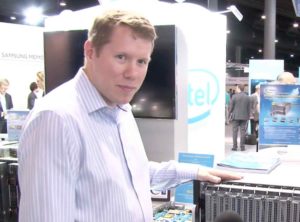 In this video from ISC 2016, Brian Watson from Supermicro describes the company’s new innovative HPC solutions for the Intel Xeon Phi processor and the Nvidia Tesla P100 GPU.
In this video from ISC 2016, Brian Watson from Supermicro describes the company’s new innovative HPC solutions for the Intel Xeon Phi processor and the Nvidia Tesla P100 GPU.
“With Supermicro HPC solutions deep learning, engineering, and scientific fields can scale out compute clusters to accelerate their most demanding workloads and achieve fastest time-to-results with maximum performance per watt, per square foot, and per dollar,” said Charles Liang, President and CEO of Supermicro. “With our latest innovations incorporating Intel Xeon Phi processors in a performance and density optimized Twin architecture, 8-socket scalable servers, 100Gbps OPA switch for high bandwidth connectivity, and high-performance NVMe for Lustre based storage, our customers can accelerate their applications and innovations to address the most complex real world problems.”
At ISC 2016, Supermicro debuted the latest innovations in HPC architectures and technologies including a 2U 4-Node server supporting new Intel Xeon Phi processors (formerly code named Knights Landing) with integrated or external Intel Omni-Path fabric option, together with associated 4U/Tower development workstation; 1U SuperServer supporting up to 4 GPU including the next generation P100 GPU; 7U 8-Way SuperServer with 24TB memory capacity supporting the new Intel Xeon processor E7-8800 v4/v3 product families and up to 8 Intel Xeon Phi coprocessors or GPU cards; All-Flash High-Availability-in-a-Box SuperStorage 2U 40-Bay dual-port NVMe system with dual node “Simply Double” based storage exhibiting up to 5Tb/s throughput and over 1.28PB storage capacity in a 42U rack; Lustre High Performance File system; and 1U 48-port top-of-rack network switch with 100Gbps Intel Omni-Path Architecture (OPA) providing a unique HPC cluster solution offering excellent bandwidth, latency and message rate that is highly scalable and easily serviceable.
Supermicro also showcased the high efficiency 1U 10 NVMe Ultra SuperServer; highest density and efficiency 3U/6U MicroBlade, 7U SuperBlade featuring 20 DP nodes or 10 DP nodes with 20 GPU/Xeon Phi; robust 4th generation Twin architecture 2U TwinPro featuring 2 DP nodes and redundant Titanium Level high-efficiency (96%+) power supplies; and DP SuperServer systems supporting Intel Xeon Phi coprocessors or GPU cards in 2U/4, 4U/8, and Tower/4+1 configurations.
Supermicro is poised to bring some of the most exciting HPC products to market using the Intel Scalable System Framework,” said Charles Wuischpard, vice president, Data Center Group, and general manager, High Performance Computing Platform Group, at Intel. “Supermicro’s adoption of our latest technologies, including the new Intel Xeon Phi processor and Intel Omni-Path Architecture will deliver remarkably deeper insights and innovations for research and commercial applications in science, analytics, and machine learning.”




